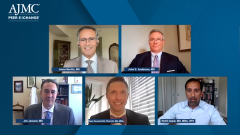
Notable Updates to ACC Guidelines
Dr Haumschild leads an overview of updates to ACC guidelines directing treatment of patients with heart failure.
Episodes in this series

Ryan Haumschild, PharmD, MS, MBA: What were the most notable updates from the [American College of Cardiology] guidelines for you? You talked a lot about this in your heart failure overview. Do you have any key thoughts in terms of these updates and how they might change or influence practice moving forward?
Jaime Murillo, MD: Thank you for that great question. I already mentioned a couple. Those guidelines are probably the best heart failure guidelines we’ve had in many years, because it’s building angles in areas that we didn’t know we should be focusing on beyond the clinical aspects. One of them was the emphasis on identifying populations at risk. The other is identifying populations that are pre-heart failure and what we can do to prevent them from moving into the symptomatic stages C and D. That’s one aspect that’s critical.
Another aspect is heart failure with preserved ejection fraction. I had the fortune of working on diastolic dysfunction more than 20 years ago, and around that time, there were cardiologists who said, “Heart failure with preserved ejection fraction doesn’t exist. What are you talking about?” And now it turns out that half of those patients with heart failure have preserved ejection fraction. This is an area that has become more exciting because we now have options for them. It isn’t just saying, “Try not to eat your pizza, because you’re going to end up in pulmonary edema.” It’s, “This is what we can do to prevent you from worsening that condition.”
The third one is value statements. Those cost considerations are critical for us moving forward. The last one is the excitement of having new groups of medications, some of them that we already knew, like ARNIs [angiotensin receptor-neprilysin inhibitors], but also having SGLT2 inhibitors playing such a central role in making these patients better and playing a role in different populations. It isn’t just those who initially were in the diabetes group, for instance. It’s also groups that are much larger than that, which allows us to think differently about what the pathophysiology of heart failure is. I don’t think we have it right yet. That will also lead us to the phenotyping part of the story that we can talk about later.
Ryan Haumschild, PharmD, MS, MBA: Excellent thoughts, I appreciate that. Dr Uppal, I want to hear your thoughts in terms of the guidelines and how they’ll influence or update decision-making. It sounds like you’re doing a lot of the latest treatments already. But do you see the guidelines making any additional influence in the way that you and your colleagues practice?
Rohit Uppal, MD, MBA, SFH: As a hospitalist, we see a skewed sample of patients. You asked me about the changes in the guidelines. We’re fortunate to have all of these evidence-based therapies and processes that are proven to improve outcomes for heart failure, but the reality is that there’s still a significant gap between where the research is and what we see in the real world. There are still a lot of opportunities to systematize processes from previous guidelines.
In other words, in the real world, we aren’t meeting the recommendations that were [made] in the past. But that being said, there are some changes that will result from these updates. One thing I see as a hospitalist is that we can be more aggressive and confident in patients who are in the stage A category where we know they’re at risk for developing CHF [congestive heart failure]. Where we might have been more passive in the past and maybe think, “The primary care doctor can start medication,” we can be more aggressive about treating that high blood pressure, knowing that we can help prevent CHF from developing.
For patients with active heart failure, we now know that once they’re stabilized in the hospital, we can begin therapy with an ARNI and feel comfortable doing that, knowing it’s safe. Starting that in the hospital rather than trying to arrange for that to be done in the outpatient setting makes it much more likely that our patients will be on that evidence-based therapy. Then for our patients who are at high risk of readmission and already on goal-directed therapy, we now know that we can add SGLT2 inhibitors and that will further improve outcomes for our patients.
One thing we’re always focused on with patients with very advanced heart failure is teaching our hospitalists the skills and making sure our multidisciplinary teams are focusing on the appropriate referral for either advanced heart failure specialists or palliative care. In general, our referrals to hospice are often too late. That’s complicated, because patients with stage D heart failure have a really unpredictable course. It makes the timing of referrals to higher levels of advanced heart failure specialists or to hospice so challenging, but these guidelines support us continuing to put a focus on that piece of it.
Ryan Haumschild, PharmD, MS, MBA: Dr Uppal, you had a lot of great comments about the continuum of heart failure. One of the things you hit on was about pre-heart failure, the patients for whom we’re starting to see the rise in blood pressure, and how do we prevent that.
Transcript edited for clarity.
Newsletter
Stay ahead of policy, cost, and value—subscribe to AJMC for expert insights at the intersection of clinical care and health economics.






























































